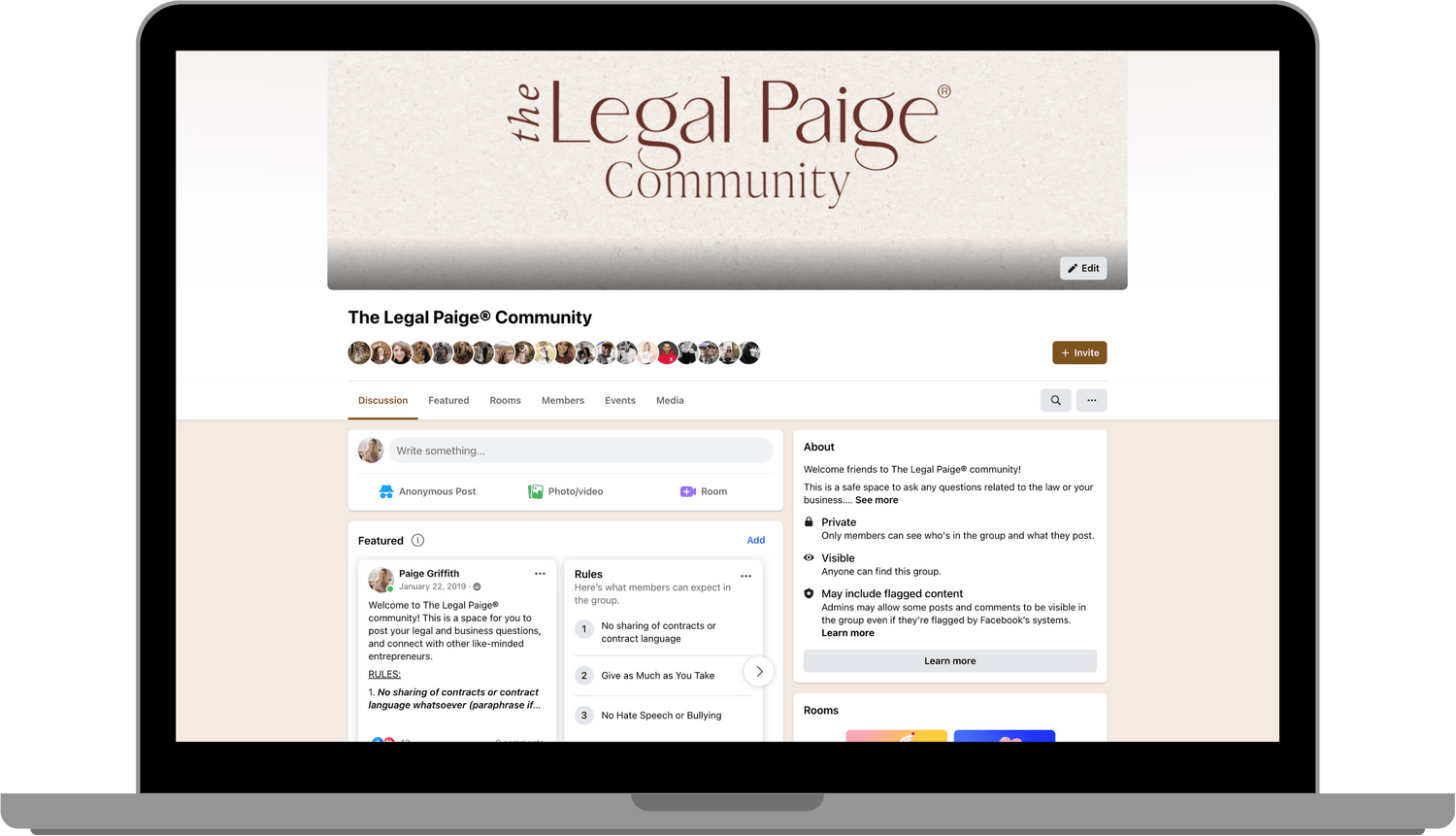
The New CARES Act and How a $10,000 Grant Can Help Your Business RIGHT NOW
As I’ve been supporting small businesses over the past 3 weeks, and especially event industry vendors, I’ve noticed A LOT of financial stress and fear. You may have been (1) working financially month-to-month or (2) prepared with a three- to six-month emergency fund buffer. Regardless, you still need to plan for what’s next, including what happens if that emergency fund runs out. No one knows how long this Covid-19 situation will last. What you need right now for your business is CASH. Luckily, the government has stepped up to help.
On March 27, 2020, the CARES Act was passed in response to the difficulties that businesses are facing as a result of the COVID-19 pandemic. This Act provides some amazing opportunities for small business owners in these trying times, and we here at The Legal Paige want to give you all the information you need to not just survive, but thrive during this time. Although the actual stimulus bill is some 800 pages, we are going to tell you exactly what you need to focus on in this blog. It’s an estimated $2 trillion package, which specifically allots $10 Billion for EIDLs and $350 billion for Paycheck Protection Loans (more on those below) to help small businesses.
What is the CARES Act?
Passed on March 27, 2020, The Coronavirus Aid, Relief, and Economic Security Act (aka “CARES”) is a very new piece of legislation. It's intended to provide economic relief to individuals and businesses facing economic hardship due to the Covid-19 outbreak, and provides $377 billion worth of funds to create small business loans and other forms of assistance.
Most significantly, the CARE Acts changes and/or authorizes two types of loans by the Small Business Administration (SBA):
- Small Business Administration (SBA) 7(a) Loans
- Economic Injury Disaster Loans (EIDL)
A Little More About the “SBA 7(a)” Loan Program
The SBA has amended their regular loan program to provide for what’s called a “Paycheck Protection Program Amendment” to help small businesses during COVID-19.
This program allows borrowers to borrow up to 2.5 times their monthly payroll expenses (up to $10 million), which can be used for qualified payroll costs, rent, utilities, and interest on mortgages. These loans notably don't require personal guarantees or collateral, which administration officials are hoping will make for a speedy approval process. The loans will have a maturity of 2 years, a 0.5% interest rate, and payments will be deferred for six months. The covered period for this loan is February 15th, 2020- June 30th, 2020.
These loans also can be partially or fully forgiven, if businesses met certain requirements set out by the SBA.
To be eligibility for this type of small business loan you must:
- Have been operational on February 15th, 2020
- Have 500 or less employees
- Have paid salaries and payroll taxes to employees or paid independent contractors
- Be substantially impacted by public health resources related to COVID-19
- Make a good faith certification that your business:
- Has been affected by COVID-19
- That the funds will be used to retain their workers, maintain payroll, and address other debt obligations; AND
- You are not receiving funds from another SBA program for the same uses
If your business has 500 or fewer employees, regardless of whether the business qualifies as a small business under the SBA size standards, and your businesses is in hospitality and dining you may be eligible if:
- You have more than one physical location
- You employ 500 or less employees per location; and
- You are assigned to the accommodation and food services sector under the North American Industry Classification System (NAICS)
Sole proprietors, independent contractors, and other self-employed individuals are also eligible for loans.
How to Apply:
The program opens Friday April 3rd, 2020.
Borrowers should reach out directly to SBA qualified lenders authorized and participating in the Paycheck Protection Program in order to apply. A sample application form can be found here.
A little more about the Economic Injury Disaster Loans (EIDL)
Another source of assistance is the Economic Injury Disaster Loan Program. This disaster loan assistance program helps small and medium-sized businesses by providing low-interest loans and GRANTS!!!! (i.e. you don’t have to pay it back) to give businesses necessary working capital until normal operations can resume. The SBA is making loans for up to $2 million available for small businesses and nonprofits in declared disaster areas under this program, which could prove to be a vital resource. These specific Disaster Loans can be used to meet financial obligations and operating expenses that the business would otherwise have been able to meet if the disaster hadn’t occurred.
In addition to currently eligible entities for SBA 7(a) Loans, the following businesses are also eligible:
- Businesses with 500 or fewer employees
- Sole proprietorships, with or without employees, and independent contractors
- Cooperatives with 500 or fewer employees
- Employee Stock Ownership Plans (ESOPs) with 500 or fewer employees
- SBA also empowered to approve applicants for small-dollar loans solely based on borrower’s credit score or alternative appropriate methods to determine an applicant’s ability to repay
One thing that’s always good to know about loans like this that are readily available is the interest rate and payback term. Here’s what that looks like:
- 3.75% fixed interest rate on loans for small businesses
- 2.75% fixed interest rate on loans to non-profit companies; and
- Up to 30 year term and amortizations, determined on a case-by-case business.
Finally, in addition to these new loan amounts and designated uses, the CARES Act waived certain previous requirements of the EIDL, including the requirements that:
- Borrower provide a personal guarantee for loans up to $200,000
- Eligible business be in operation for one year before the disaster; and
- The borrower be unable to obtain credit elsewhere.
But, Paige, what are all these “grants” about?! I heard you can get $10,000 now?!
Under the EIDLP, small businesses can request immediate funds, and are eligible to receive an emergency advance of $10,000 within 3 days after applying for an EIDL GRANT!!!! If this grant is approved, that grant can be used to pay for your businesses:
- Payroll
- Increased material costs
- Rent or mortgage payments; or
- Repaying obligations that cannot be met due to a loss of revenue.
Again, these grants can be forgiven. Applicants can get the emergency cash even if they don’t qualify for additional funds. Because lending decisions are based on self-certification and the applicant’s credit score, the review process should go quickly through the SBA. And, this stimulus bill also waives the requirement that business owners be unable to obtain credit elsewhere. That means you can apply even if you already have a credit line! Oh, and there are no loan fees, guarantee fees, or prepayment fees.
How to Apply:
Businesses that qualify can apply online at the SBA’s website here.
For this application you will need:
- Your business’s info including EIN
- All business owner personal info: SS#, date of birth, place of birth, home address
- Last 12 months of total gross sales; enter YTD 2019 should suffice- asks through 1/31/20
- Last 12 months total expenses, again provide 12/31/19 YTD.
- Bank account and routing number
You'll also need to provide a signed and dated 4506-T Form that gives the IRS permission to provide the SBA with tax return information.
Also… no one really knows how long these applications are taking to process. There are around 30 million small businesses in the United States, so it's going to take time for the SBA to go through the applications.
Other Considerations To Keep in Mind:
With any financial decision that you make as a small business, there are some additional considerations to keep in mind when considering utilizing whether to apply for either of these programs for your business:
- You can apply for assistance from BOTH the Paycheck Protection Program and the EIDLP. However, each loan can’t be used for the same purpose, so you should evaluate both programs and choose accordingly.
- There is a limited amount of funds under the CARES Act, so Paycheck Protection Program loans may be made on a first come, first serve basis. If you are interested in this program, you should reach out to banks and lenders and begin the process as soon as possible. Applications are available beginning April 3, 2020 (today!), and a sample application can be found on the SBA website.
- Review for EIDLs takes about 5 days. If it is approved, the disbursement of funds occurs 3 weeks after the date of approval. However, as the number of applicants increases, disbursement is likely to make more than 3-4 weeks, so it may be in your best interest to start the application process as soon as possible.
Links:
For Further Information Visit:
Small Business Administration's Website
Small Business Owner’s Guide to the CARES Act
-The Legal Paige® Facebook Community -
THIS BLOG POST IS NOT A SUBSTITUTE FOR LEGAL ADVICE. EVERY SITUATION IS DIFFERENT & IS FACT-SPECIFIC. A proper legal analysis is necessary based on your location and contract. Consult an attorney in your home state for advice regarding your contract.
See our full disclaimer here.

Join the Community
Be a part of 8000+ TLP Community Members in this safe space and get real-time answers from Paige and her legal team daily!

Leave a comment